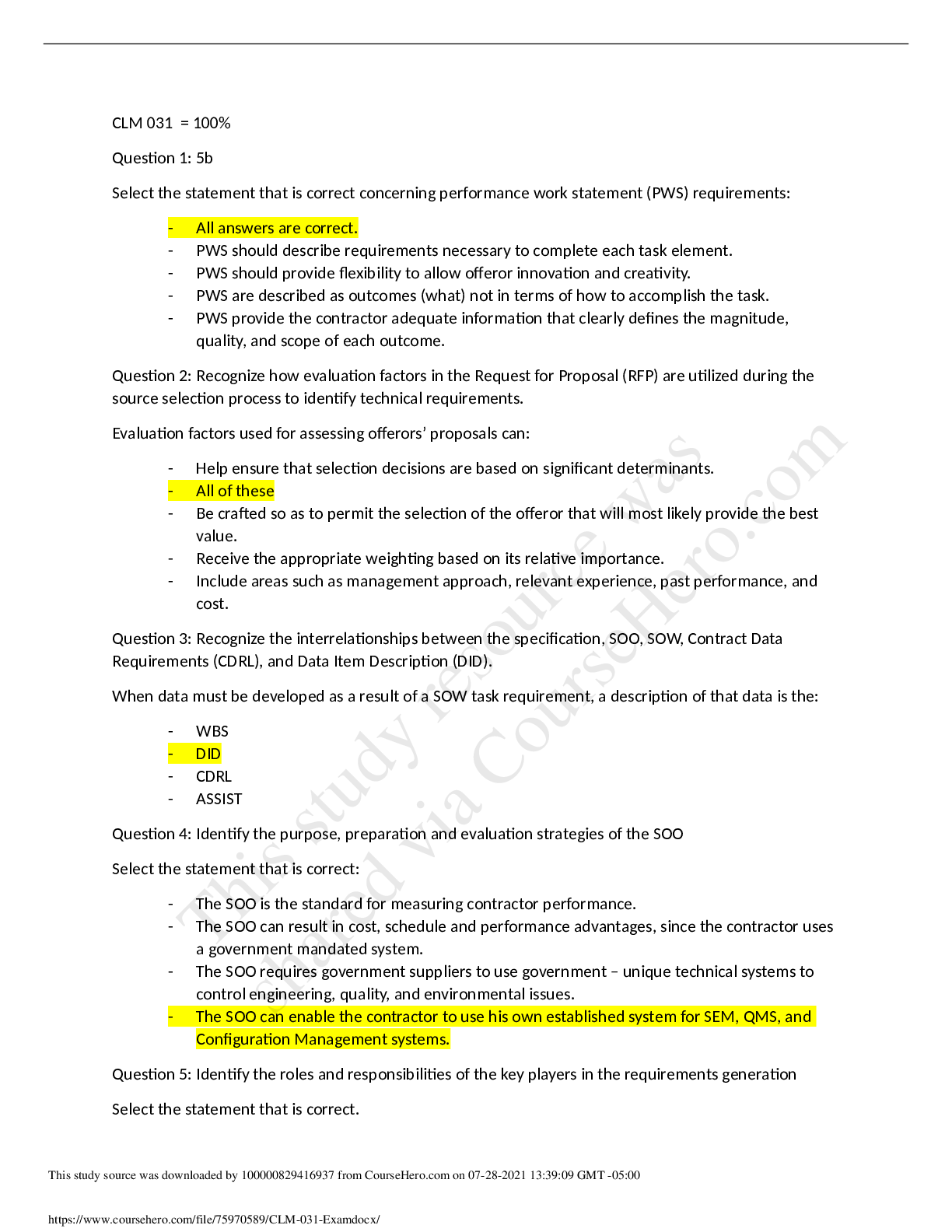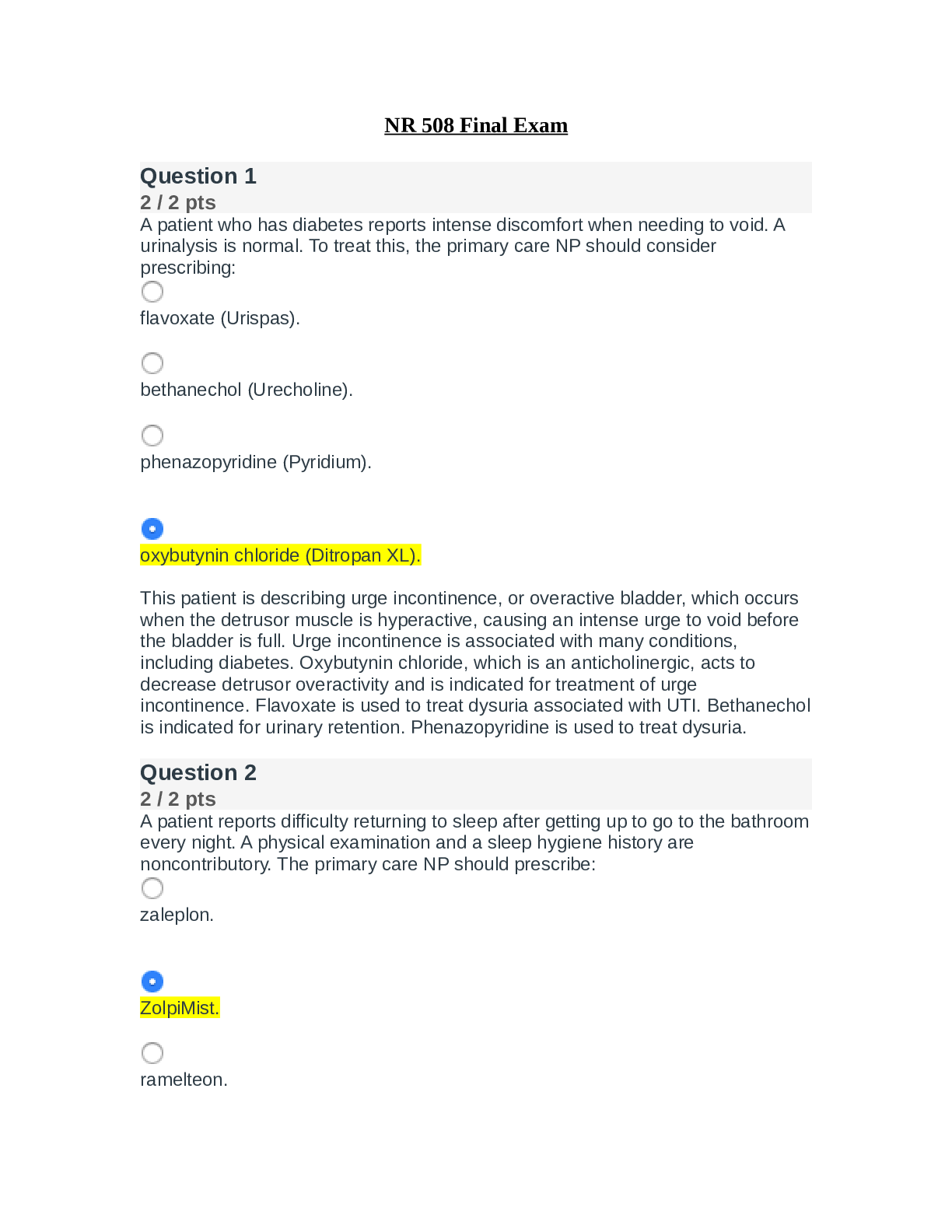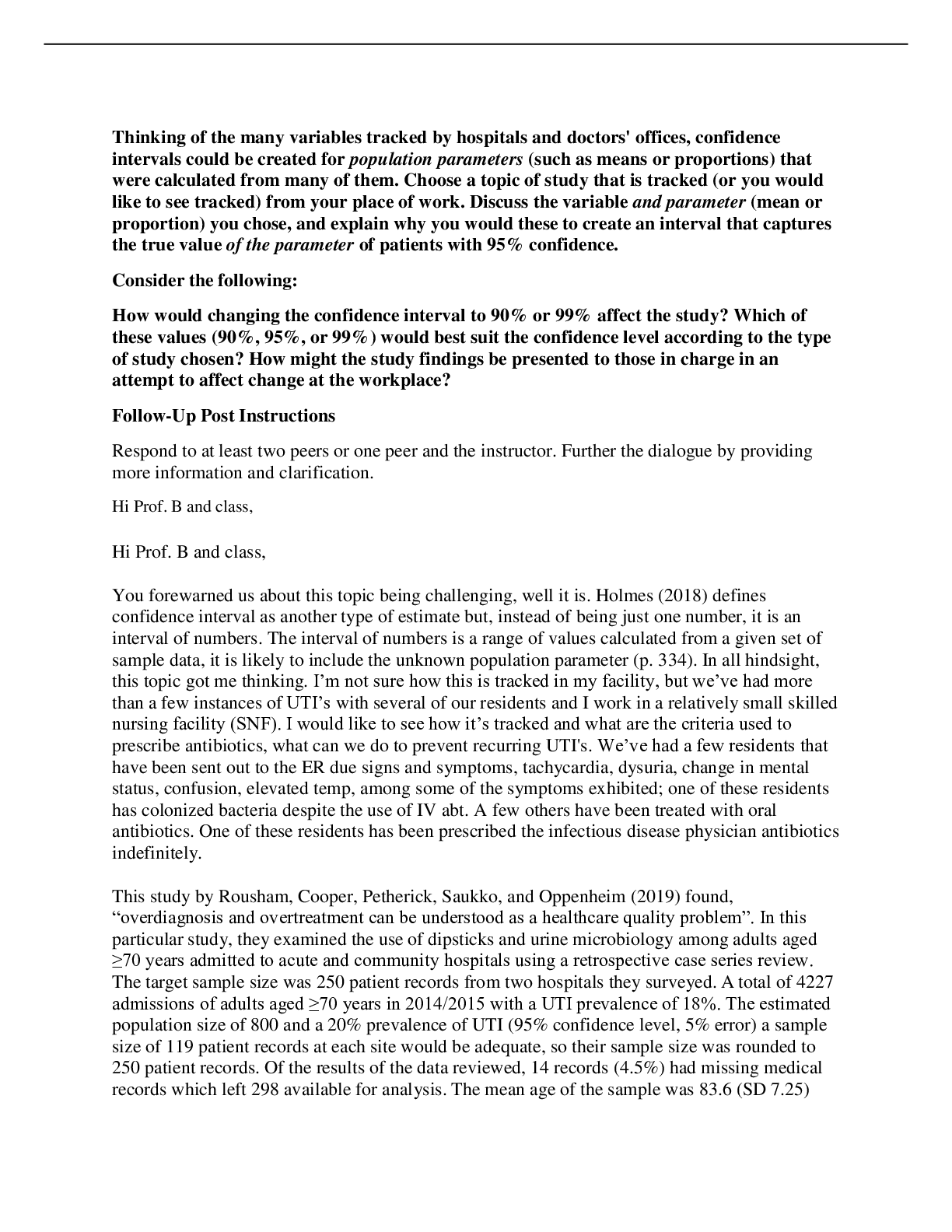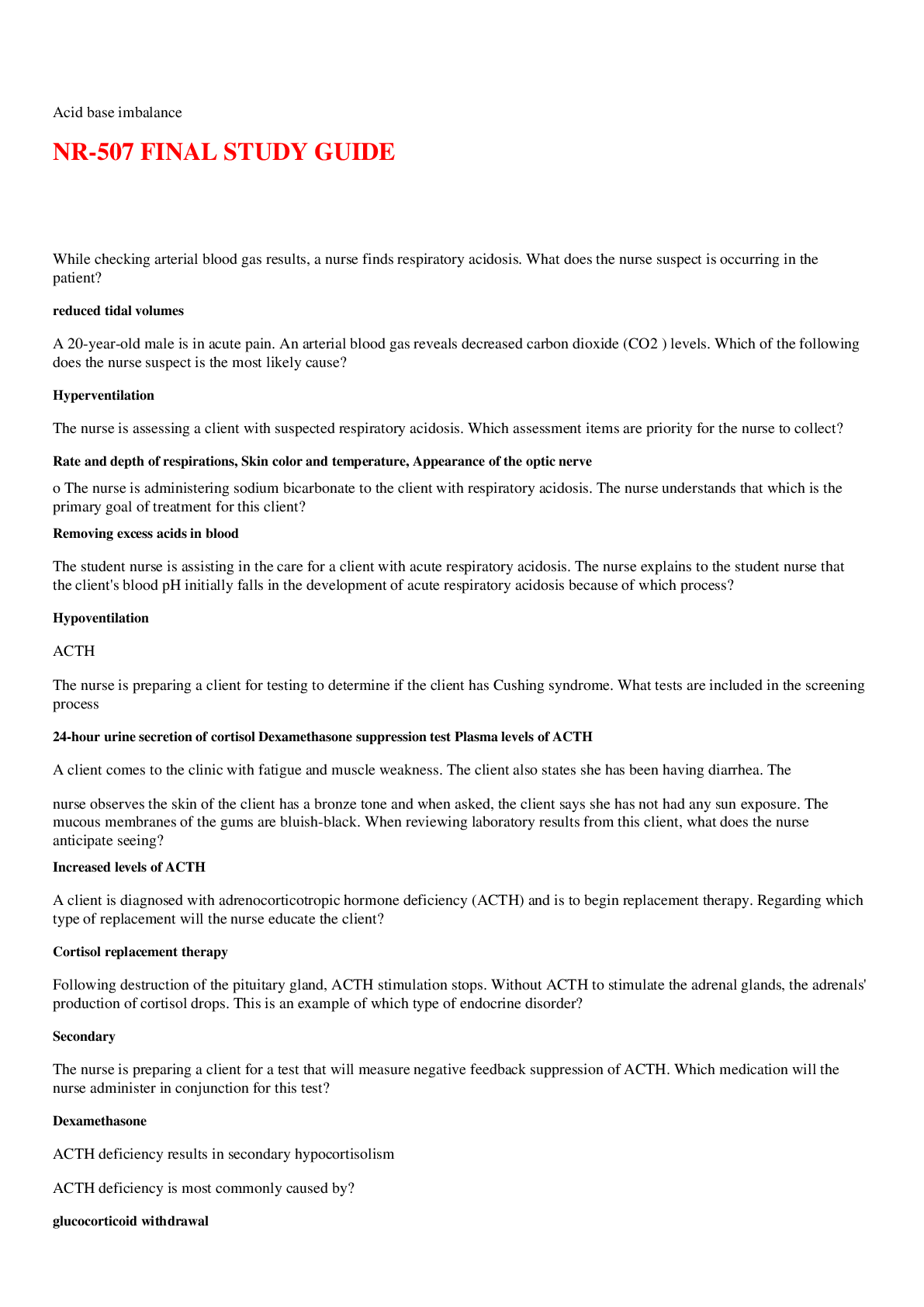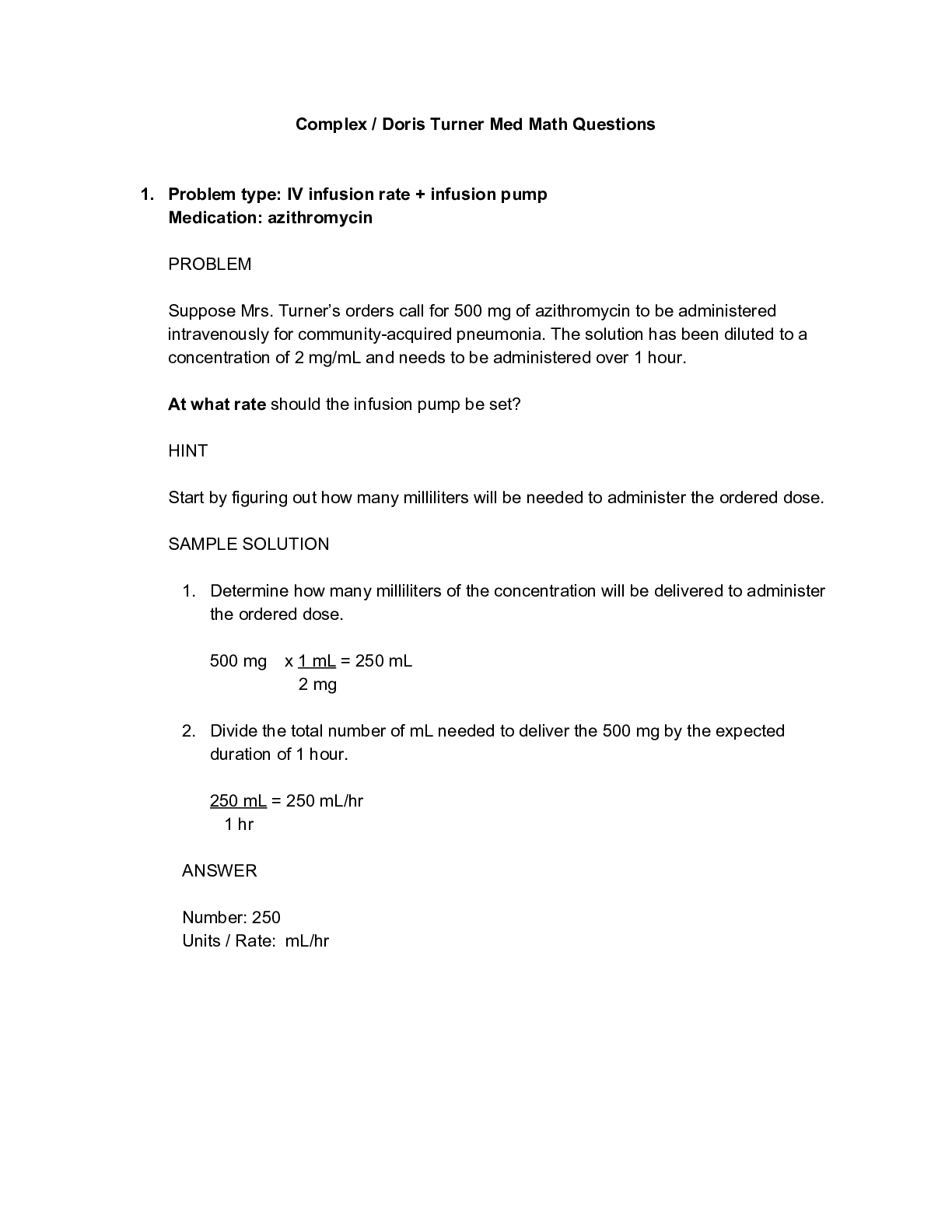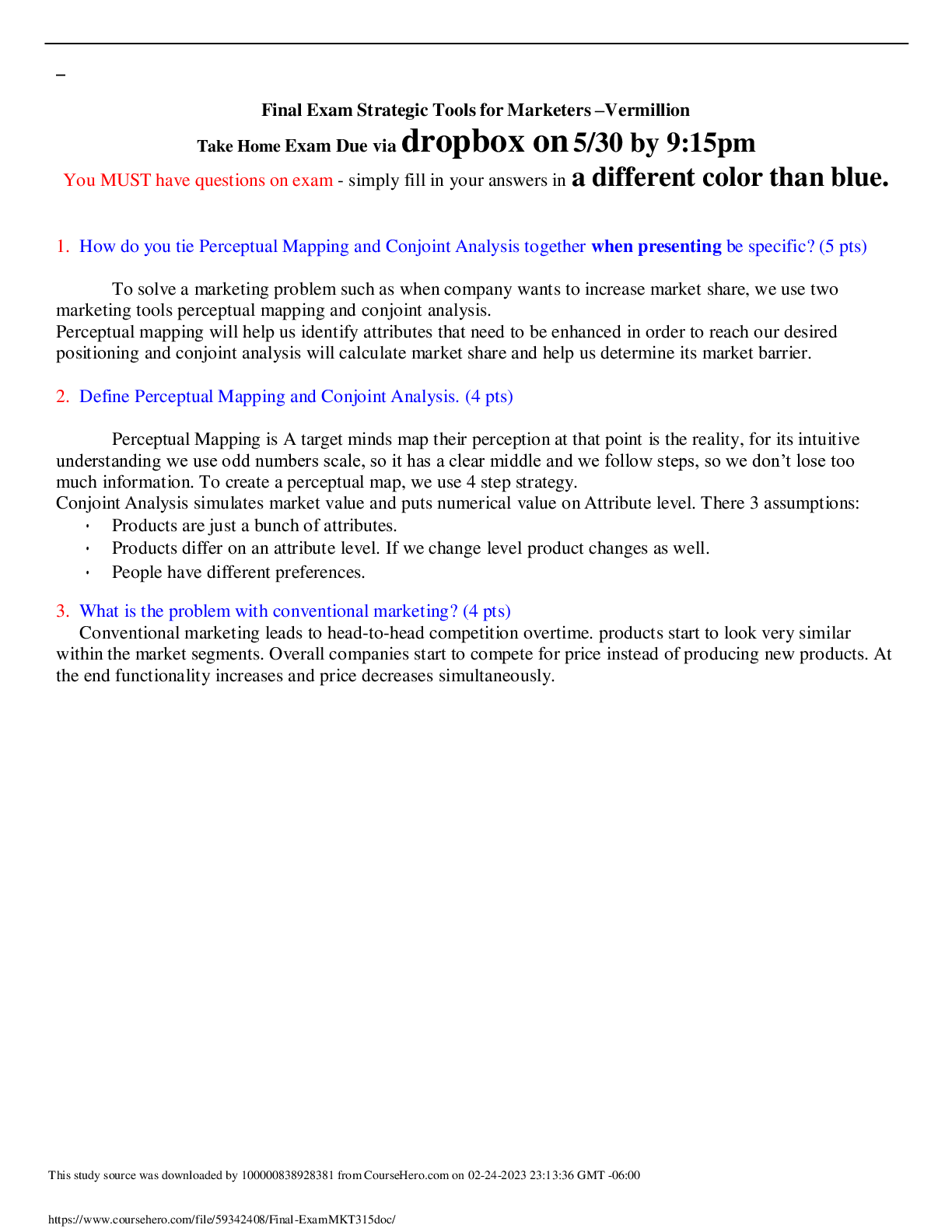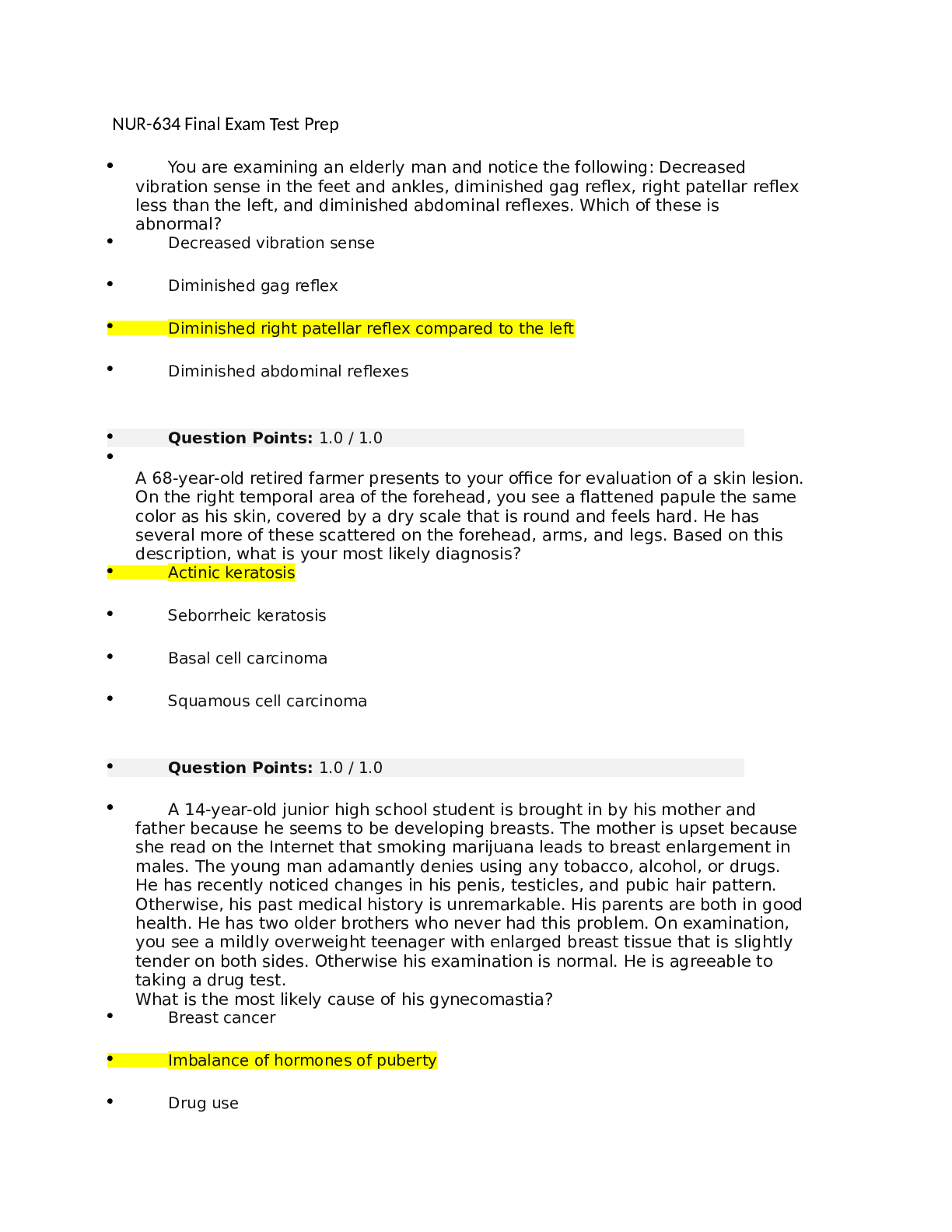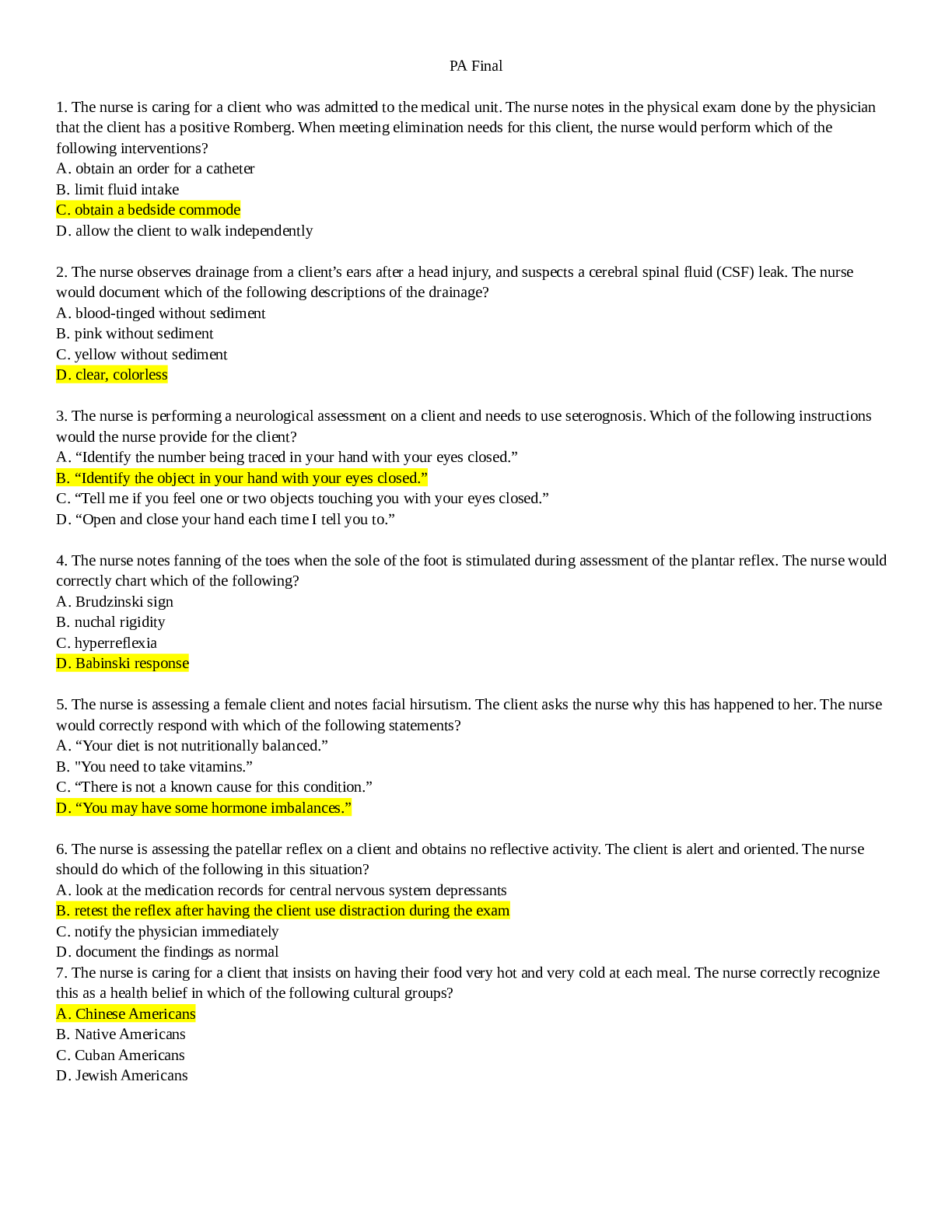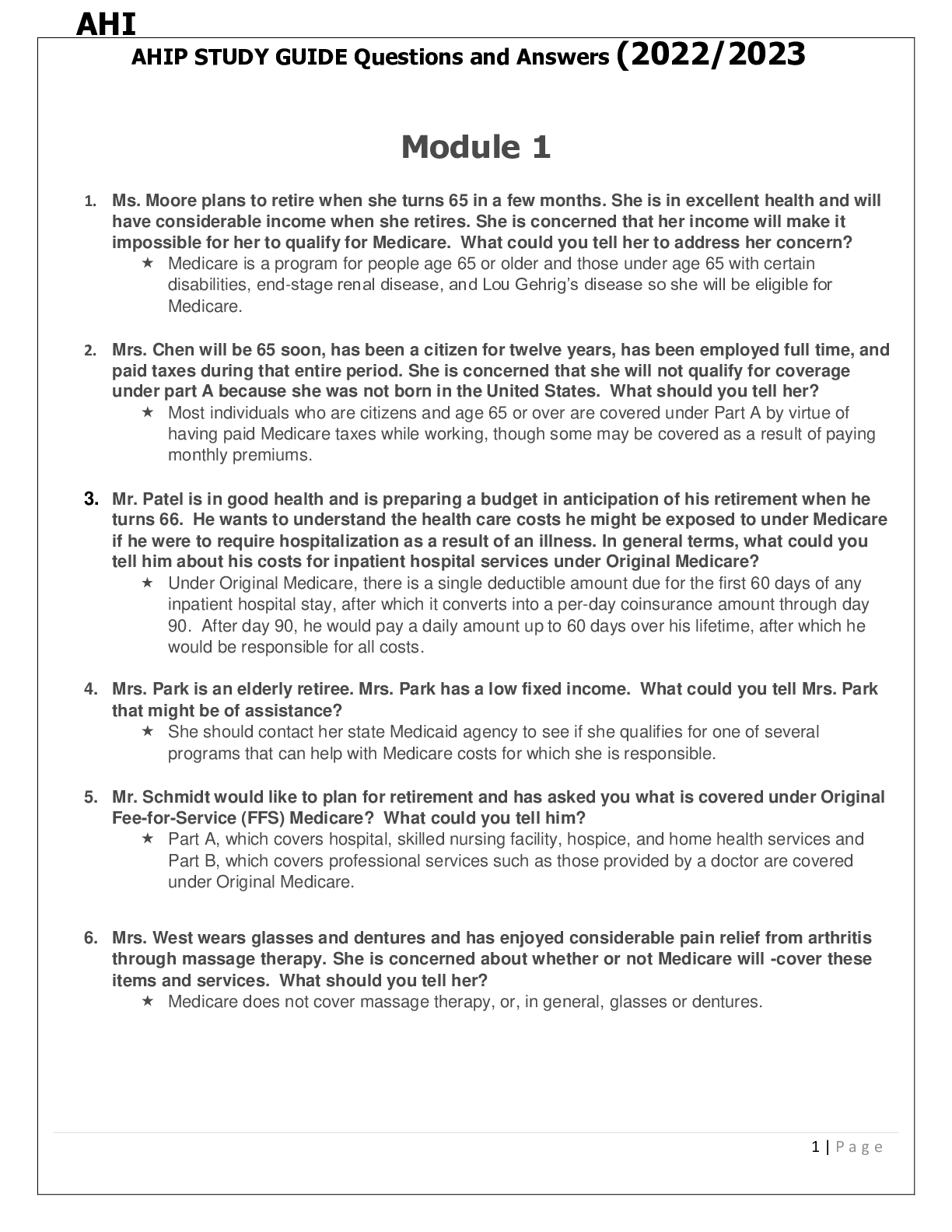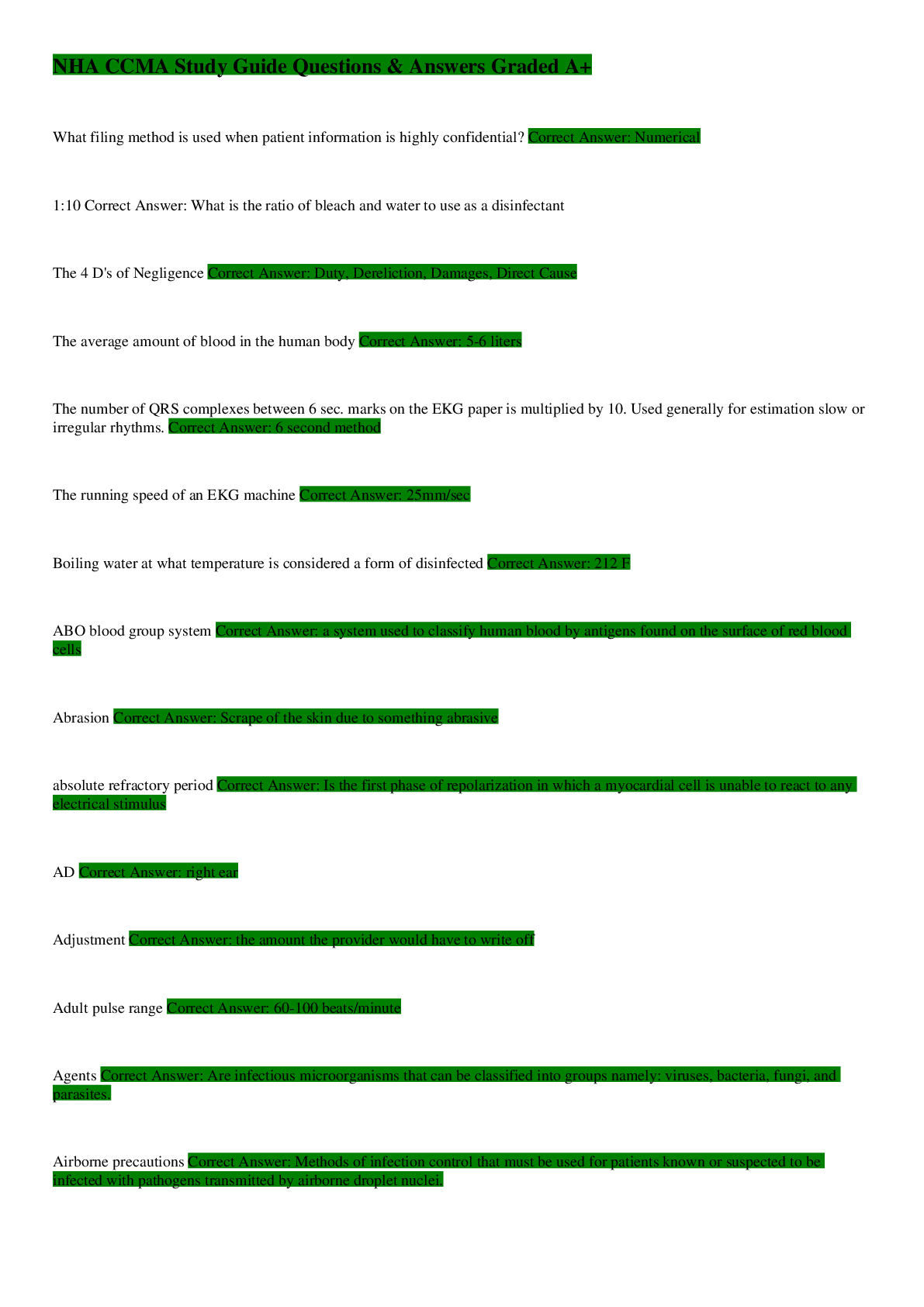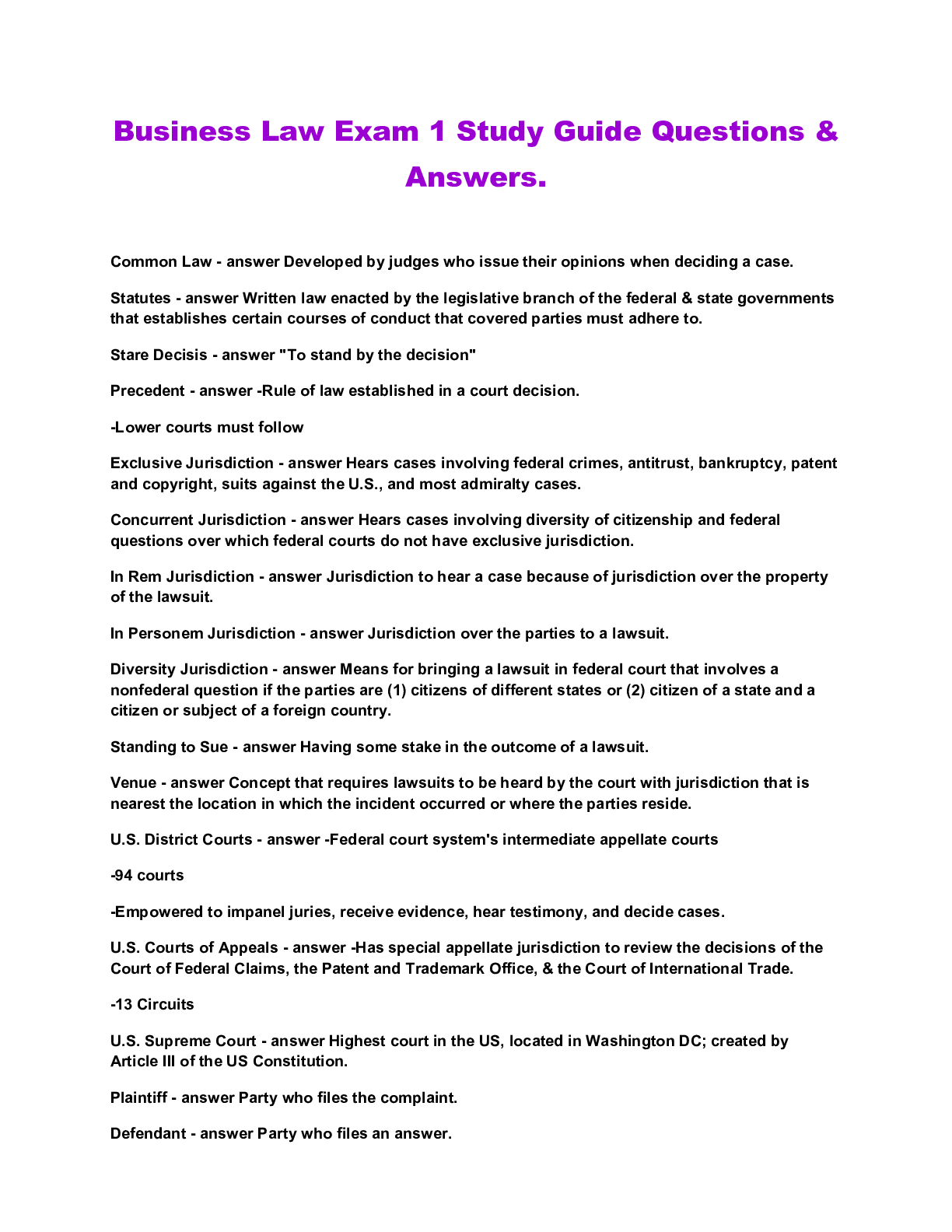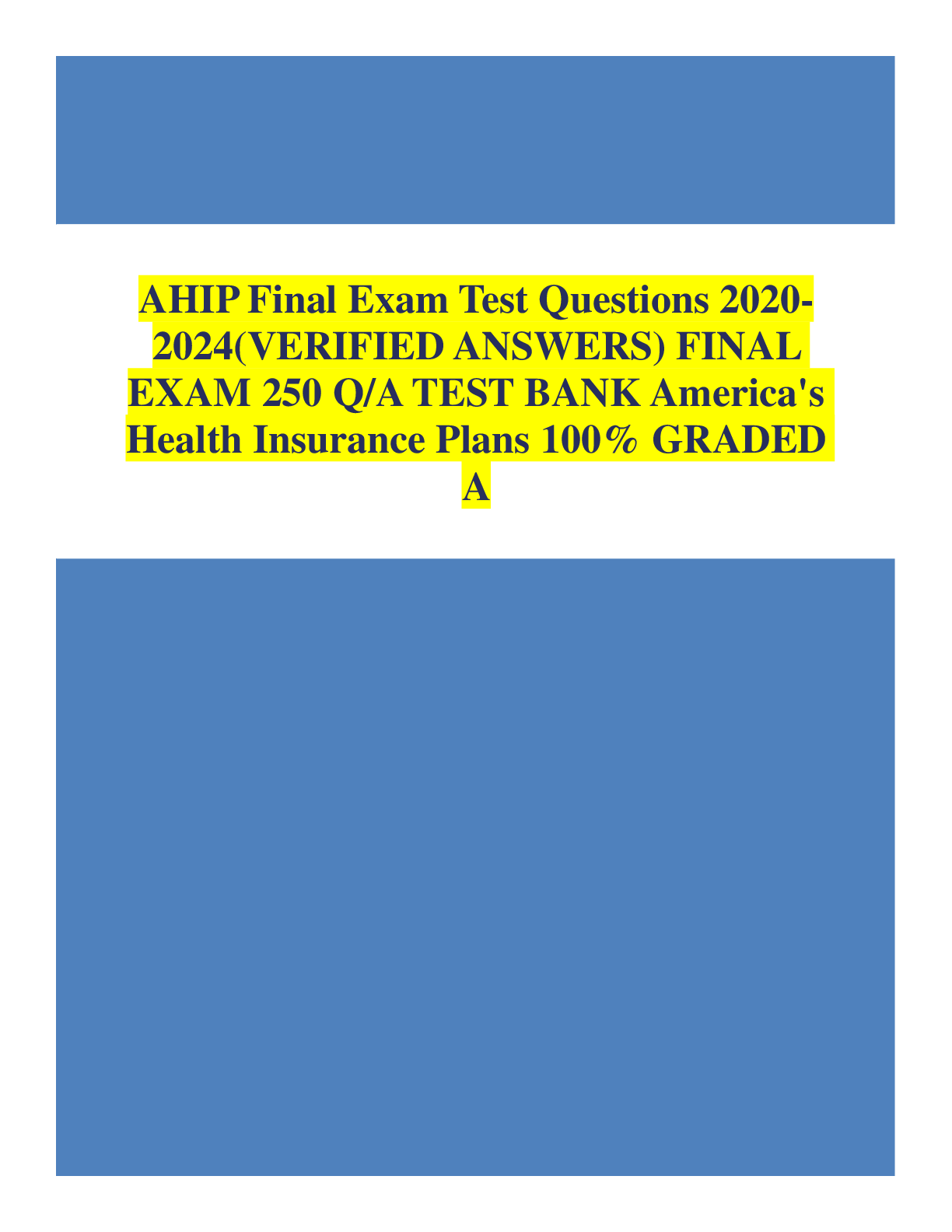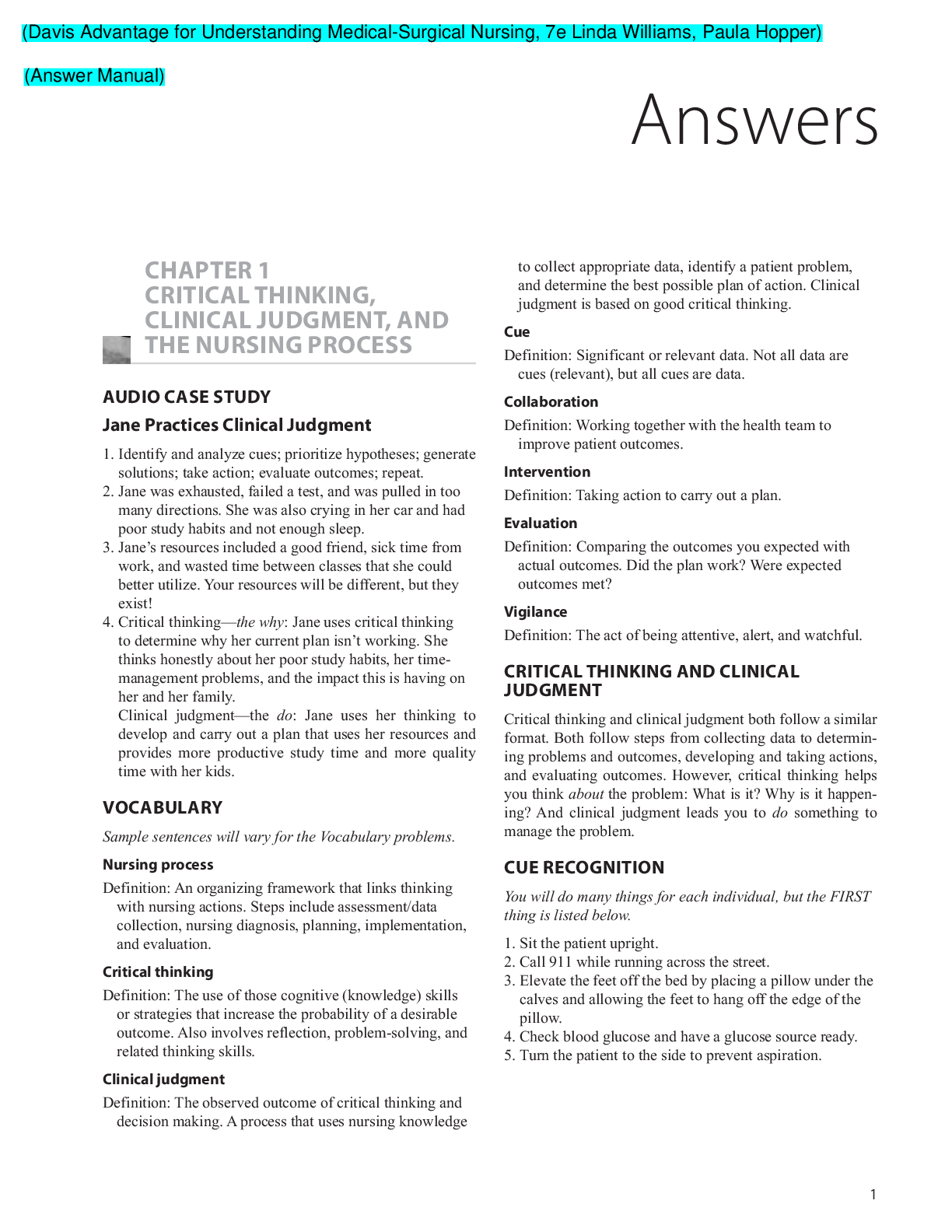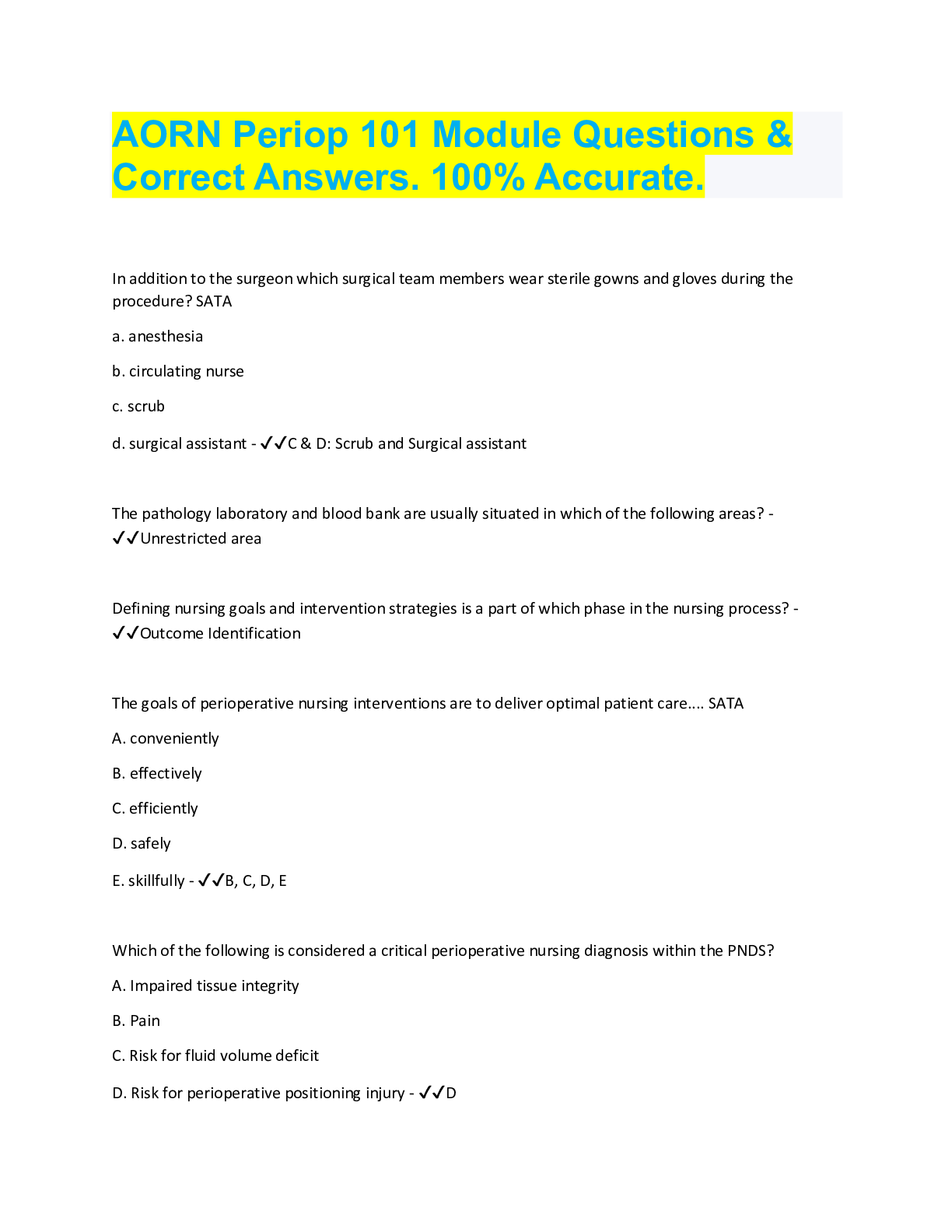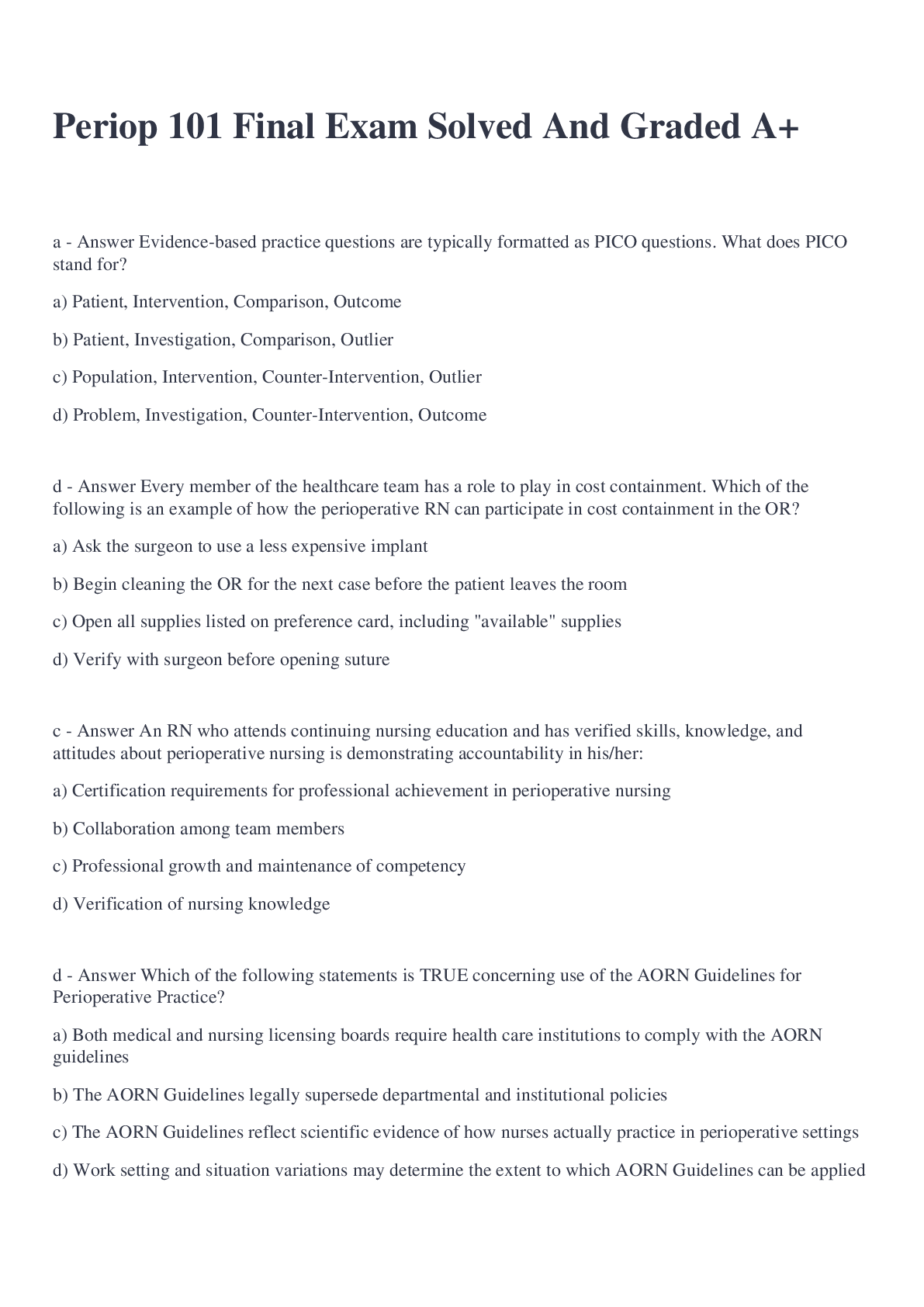*NURSING > QUESTIONS & ANSWERS > NUR2092 Health Assessment Final Study Guide Questions & Answers, Rasmussen College. GRADED A (All)
NUR2092 Health Assessment Final Study Guide Questions & Answers, Rasmussen College. GRADED A
Document Content and Description Below
NUR2092 Health Assessment Final Study Guide Questions & Answers. Abnormal resp sound: Snap crackle pop: Crackles. Cardiac cycle, ventricles are pushing blood out of the ventricles is : Nurse is assess... ing an older adults instrumentals of activities of daily living : Obese client, BP cuff is standard size: Know Erb’s point and Mitral Valve locations. Patients skin is shiny and tight without hair: Peripheral Artery Disease: Is! Enlargement of the fingers and nails, angle greater than 180. Nodules Person goes in for regular yearly exam and mentions engaging in light exercise: Nurse would ask deformities are with: Thoracic Expansion assesses? Swishing sounds loudest in 4th intercostal space left sternal border: Edema: 2mm pitting: Red Black Tarry Stool: Eye opening, verbal response, and motor response. doesn’t work what should you do? HAve patient lock his arms together and try to pull them apart Abnormal response to Romberg test? Cranial Nerve number 5&7 facial touch Stage 3 pressure ulcers. Deep Tendon reflexes: Fracture picture: Know the difference Know about is ringing buzzing crackling in ear. is crunching grating sound of clients knee. Rashes: Vertigo is….. What is the last thing a culture gives up when adapting to a new culture? Patient has N and in. Expect to find pain on percussion Primary secondary tertiary. …. …. Tests for Gross hearing ability. Skin color is included in Non Modifiable colon cancer risk factor is: Dorsiflexion is ….. Diagnosis with Pneumonia …. Nurse can clearly hear 99 in left lower lobe __________________________________________________________________________ Kahoot: 1. What occurs in the diagnosis step of the nursing process? 2. Which Statement will elicit the most information? 3. What are the characteristics of lymph nodes in clients with 4. A client has a left femur fracture repair, which is of the most concern to the nurse? 5. What is a symptom of 6. How does the nurse document raised 0.6 cm, firm lesion noted on a client’s arm? 7. Where can bronchial breath sounds be heard? 8. 58 year old finds small lump in breast, what data history 9. Which assessment is appropriate for evaluating cerebellar function? 10. Perform spinal assessment and note excessive inward curvature of the lumbar spine, this is: 11. What is a sign of right sided congestive heart failure: 12. A raised firm lesion almost 4 cm: 13. What order does nurse auscultate heart valves? 14. Assessing ROM clients ankles nurse expects client to perform 15. Which guideline may be used to identify which heart sounds is S1? 16. Heberden and Bouchard nodes are associated with what condition? 17. What does tactile fremitus assess? 18. Swooshing sounds loudest at 2nd intercostal space, Rt border. Problem valve? 19. Romberg: Pt sways and moves feet farther apart. Document? 20. Pt s/s: severe headache, vomiting and rash. Nurse would suspect 21. Common change seen in geriatric clients? 22. What is an appropriate tool to evaluate pain on a 5 year old with a broken arm? 23. Muscle is relaxed and part? ROM 24. Heard loudest at 2nd intercostal space, Rt and Left of sternal borders 25. s/s nurse considers cataracts as diagnosis eye 26. Ausculates ABD aorta, hears swishing sound. Nurse suspects? 27. 50 year old to have colonoscopy. What level of health promotion is this? 28. What is a non-modifiable colon cancer risk factor? 29. Tongue movement and tongue strength. This tests cranial nerves? PRACTICE QUESTIONS: 1. The nursing student is learning blood pressure techniques and asks the instructor what is a normal blood pressure reading? Which of the following would be appropriate response for the instructor? (c) a. Ask the client what is usual for them b. A normal reading is 140/80 c. Normal is considered to be less than 120/80 and above 100/60 d. “That depends on the client” 2. “A 65yr old man with emphysema and bronchitis ahs come to the clinic for a follow up appointment. On assessment of his skin the nurse might expect to find the following. (a) a. Clubbing of the nails b. Scleroderma c. Pedal erythema d. anasarca 3. When the client’s chart includes a notation that Petechiae have been observed, what finding does the nurse expect during inspection? (a) a. Purplish-red pinpoint lesions b. Deep purplish or red patches of skin c. Small raised fluid-filled pinkish nodules d. Generalized reddish discoloration of an area of skin 4. Which of the following situations will result in a falsely high blood pressure? Select all that apply (a,c.) a. The blood pressure cuff is too narrow for the extremity. b. The cuff has a small tear on the side of it c. The person is sitting with his or her legs crossed d. The nurse does not inflate the cuff high enough. 5. The nurse is assessing capillary refill on a client and notes a color return that takes 4 seconds on each hand. The nurse would correctly document this finding as which of the following? (b) a. Normal b. Sluggish c. Absent d. Brisk 6. The nurse has discovered decreased skin turgor in a patient and nows that this in an expected finding in which of the following conditions? (C) a. During childhood growth spurts b. Cases of severe obesity c. An individual who is severely dehydrated d. With conditions of connective tissue disorders such as scleroderma 7. A Mother brings her newborn in for an assessment and asks, “Is there something wrong with my baby? His head seams so big.” The nurse knows the following about relative portions of the head and trunk of the newborn. (A) a. HEad circumference should be greater than chest circumference at bitrh. b. At birth, the head is one fifth the total length c. The head size reaches 90% of its final size when the child is 3 y.o d. When the anterior fontanel closes at 2 months, the head will be more proportioned to the body. 8. The Nurse educator is preparing an education module for the nursing staff on the epidermal layer of skin. Which of the following would be included in the module? (A) a. The epidermis is replaced every 4 weeks b. The epidermis is very vascular c. The epidermis is thick and tough d. The epidermis is thin and non stratified 9. The nurse is assessing a patient’s pain. The nurse knows that which of the following is considered the most reliable indicator of pain? (B) a. Vital Signs, b. The subjective report c. The physical Examination d. Computerized axial tomography scan finding. 10. The nurse is aware that the four areas of the body where lymph nodes are accessible are the: (D) a. Head, breasts, groin, and abdomen. b. Arms , breasts, inguinal area, and legs c. Head and heck, arms, inguinal area, and axillae d. Head, neck, arms, inguinal area, and axillae 11. To assess for jaundice the nurse would inspect for: (B) a. Ashen-gray color in the oral mucosa membranes b. Yellow pigmentation in the sclera c. Very pale skin on the palms d. Bluish color in the axilla and groin 12. A 4y.o boy is brought to the ER by his mother. She states that he points to his stomach and says “It hurts so bad.” Which pain assessment tool would be the best choice for when assessing this child’s pain? (C) a. The number rating scale b. The descriptor scale c. The Wong-Baker scale d. The brief pain inventory 13. When the nurse assesses an apical heart rate and notes bradycardia. What do you expect the apical heart rate to be? (D) a. Greater than 100/minute b. 60-90 BPM c. Greater than 150/minutes d. Less than 60 BMP 14. A 50 y.o. Woman with elevated serum, total cholesterol, and triglyceride level is visiting the clinic today to find out about her laboratory results. What would be important for the nurse to include in the patient teaching in relation to these tests. (A) a. Information regarding a low saturated fat diet b. The risks of undernutrition c. Methods to reduce stress in her life d. The fact that this is hereditary and there is nothing she can do to change the levels. 15. The nurse is performing a nutritional assessment on an 80 y.o patient The nurse knows that physiologic changes that directly affect the nutritional status of the elderly include: (A) a. Slowed gastrointestinal motility. b. Hyperstimulation of the salivary glands c. An increased sensitivity to spicy and aromatic foods d. Increased GI absorption causing esophageal reflux. 16. Which of the following findings should the nurse expect to find when assessing the nails of a healthy adult. (C) a. The nail base angle is not more than 90 degrees b. Whitish to clear nails in darker skinned clients. c. Smooth and rounded nails with a flat surface. d. Gradual enlargement of the distal finger. 17. A Patient's laboratory data reveal an elevated thyroxine level. The nurse would proceed with an examination of the: (B) a. Parotid Gland b. Thyroid Gland c. Adrenal Gland d. Thyroxine Gland 18. All of the following data is collected during the head-to-toe assessment except: (C) a. Mood or affect b. Hearing and Speech abilities c. Laboratory results d. Gait 19. During a nutritional assessment why is it important for the nurse to ask a patient what medications he or she is taking? (B) a. The nurse needs to assess the patient for allergic reactions b. Certain drugs can affect the metabolism of nutrients c. Medications need to be documented on the record for the physician’s review. d. Medications can affect one’s memory and ability to identify food eaten in the last 24 hours 20. A Client reports a rash that “Itches” but denies fever, SOB, or other symptoms. What does the nurse ask to help determine if the client is experiencing an allergic reaction? (A,B,D) a. Are you taking any new medications? b. Have you been using any different soaps? c. Is your skin unusually dry or flaky? d. Have you been exposed to any new cleaning solutions? e. Have you noticed any new bruises or brownish discoloration? 21. An older adult woman is brought to the ER after being found lying on the kitchen floor for 2 days. She is extremely dehydrated. What would the nurse expect during the examination? (D) a. White patches on the mucous membranes b. Smooth mucous membranes and lips c. Pale mucous membranes d. Dry mucous membranes and cracked lips. 22. Which of the following statements is true regarding the use of standard precautions in the healthcare setting? (A) a. Standard precautions are intended for use with all patients regardless of their risk or presumed infection status. b. Standard precautions apply to all body fluids, including sweat c. Airborne, droplet, and contact transmission-based precautions are included in the use of standard precautions d. Standard precautions are to be used only when there is non intact skin, excretions contain visible blood, or contact with mucous membranes is expected. 23. A patient’s thyroid is enlarged and the nurse is preparing to auscultate the thyroid for the presence of a bruit. A Bruit is a: (B) a. High pitched tinkling sound best heard with the diaphragm of the stethoscope b. Soft whooshing sound, pulsatile sound best heard with the bell of the stethoscope c. Low gurgling sound best heard with the diaphragm of the stethoscope d. Loud, whooshing, blowing sound best heard with the bell of the stethoscope 24. A Client came for their yearly health assessment provided by their employer. You are reviewing their heart history. The client mentions that they engages in light exercise. At the time you should do which of the following (B) a. Record “light” exercise b. Ask what the client means by “light exercise” c. Record that the client “walks each day” d. Ask if the client does their own house cleaning. 25. During an examination, the nurse finds that a patient has excessive dryness of the skin. The best term to describe this condition is: (A) a. Xerosis b. Alopecia c. Pruritus d. Seborrhea 26. Which technique of assessment used to determine the presence of crepitus, swelling, and pulsations? (C) a. Inspection b. Auscultation c. Palpation d. Percussion 27. In a report, the nurse learns that a client has macular rash. Which of the following best describes a macular rash? (D) a. Elevated firm, well defined lesions less than 1 cm in diameter b. Depressed, firm, or scaly, rough lesions greater than 1 cm in diameter c. Elevated, fluid filled lesions less than 1 m in diameter d. Flat, well defined small lesions less than 1 cm in diameter? 28. When evaluating a patient's pain, the nurse knows that an example of acute pain would be: (D) a. Low back pain b. Arthritic Pain c. Fibromyalgia d. Kidney Stones 29. When documenting the palpation of a pulse, the nurse is correct in recording which of the following about the rhythm? (B) a. Rhythm 100 BPM b. Irregular Rhythm c. Rhythm noted at 2 d. Bounding Rhythm 30. A patient is especially worried about an area of skin on her feet that has turned white. The health care provider has told her that her condition is vitiligo. The nurse explains to her that vitiligo is: (C) a. Caused by an excess of apocrine glands in her feet b. Caused by an excess of melanin pigment c. Caused by the complete absence of melanin pigment d. Related to impetigo and can be treated with ointment 31. When assessing a patient’s nutritional status, the nurse recalls that the best definition of optimal nutrition status is: (A) a. Sufficient nutrients to provide for daily body requirements and for increased metabolic demands. b. Nutrients in excess of daily body requirements c. Sufficient nutrients to provide for the minimum body needs. d. Sufficient nutrients for daily body requirements but not for increased metabolic demands A black patient is in the intensive care unit because of impending shock after an accident. The nurse expects to find what characteristics in this patient’s skin? (B) A. Ruddy blue B. Ashen, gray or dull C. Patchy areas of pallor D. Pale with blue extremities When auscultating the right carotid artery, the nurse hears a swishing sound (a bruit). What would this suggest?(D) A. Decreased cardiac output B. Increased central venous pressure C. Right ventricular failure D. A narrowed vessel During the aging process, the hair can look gray or white and begin to feel thin and fine. The nurse knows that this occurs because of a decrease in the number of functioning (D) A. Phagocytes B. Fungacytes C. Metrocytes D. Melanocytes A patient, 85 yr. old women, is complaining about the fact the bones in her face have become more noticeable. What explanation should the nurse give her? (B) A. Diets low in protein and high in carbohydrates may cause enhanced facial bones B. More noticeable facial bones are probably due to a combination of factors related to aging, such as decreased elasticity, subcutaneous fat, and moisture in her skin C. Bones can become more noticeable if the person does not use a dermatologically approved moisturizer. D. Facial skin becomes more elastic with age. This increased elasticity causes the skin to be more taught, drawing attention to the facial bones The nurse is assessing a patient with a heart rate of 55. Which of the following patients would be most likely to have a pulse rate of 55? (C) A. A 70-year-old telephone salesman who is dehydrated. B. A 67-year-old who presented with an exacerbation of his COPD C. A 20-year-old runner who had surgery 4 days ago for a fractured leg D. And infant who has a temperature of 100.1 degrees F. Physical growth is the best index of a child’s (B) A. General makeup B. General health C. Nutritional status D. Activity and exercise patterns Which of the following factors is most likely to affect the nutritional status of an 82-year-old person? (D) A. Increase in gastrointestinal motility and absorption B. Increase in taste and smell C. Change in cardiovascular status D. Living alone on a fixed income During an examination, a nurse notes a lesion on the client’s upper back. What is the best way to document the size of this lesion? (A) A. Use a centimeter rule to measure the lesion B. Compare its size to the size of a coin C. Estimate its size to the nearest inch D. Trace the lesion onto a piece of paper When performing a physical assessment, the technique the nurse will always use first is (A) A. Inspection B. Palpation C. Percussion D. Auscultation A newborn infant is in the clinic for a well-baby checkup. The nurse observes the infant for the possibility of fluid loss because of which of these factors? (B) A. Subcutaneous fat deposits are high in the newborn B. The newborn's skin is more permeable than that of the adult C. Sebaceous glands are over productive in the newborn D. The amount of vernix caseosa dramatically rises in the newborn When examining the face, the nurse is aware that the two pairs of salivary glands that are accessible to examination are the ________ glands (A) A. Parotid and jugulodigastric B. Occipital and submental C. Occipital and submental D. Parotid and submandibular The nurse notices that an infant has a large, soft lump on the side of his head and that his mother is very concerned. She tells the nurse that she noticed the lump approximately 8 hours after her baby’s birth and that it seems to be getting bigger. One possible explanation for this is (D) A. Caput succedaneum B. Craniosynostosis C. Hydrocephalus D. Cephalohematoma A thorough skin assessment is very important because the skin holds information about (A) A. Psychological wellness B. Support systems C. Socioeconomic status D. Circulatory status When assessing the radial pulse of a patient, the nurse should count the (A) A. Pulse for 1 minute if the rhythm is irregular B. Pulse for 15 seconds and multiply by four, if the rhythm is regular C. Initial pulse for a full 2 minutes to detect any variation in amplitude D. Pulse for 10 seconds and multiply by six, if the patient has no history of cardiac abnormalities The nurse detects a possible irregularity in the rhythm of a client’s radical pulse. Which of the following should the nurse perform? (C) A. Record this as normal for the client B. Count the radical pulses again for 15 seconds and multiply by 4 C. Count the client’s apical pulse for a full minute D. Use a stethoscope to check the brachial pulse A nurse notices multiple lesions on a client’s back that are 0.5 cm in width, elevated, circumscribed and filled with serous fluid. The nurse documents these lesions as: (C) A. Macules B. Patches C. Vesicles D. Bullae When documenting the results of palpating the pulse, the nurse is correct in making which of the following notations? (C) A. Rhythm noted at 2 B. Rhythm 110 beats/minute C. Irregular rhythm D. Bounding contour The nurse is performing an assessment on an older adult client. Which assessment data would indicate a potential complication associated with the skin of this client? (B) A. Wrinkling B. Lesion with an irregular border C. Deeping of expression lines D. Thinning and loss of elasticity in the skin A patient states that the pain medication is not working and rates his postoperative pain at a 10 on a 1 to 10 scale. Which of the following assessment findings indicates an acute pain response to poorly controlled pain? (D) A. Decreased blood pressure and pulse B. Confusion C. Hyperventilation D. Increased blood pressure and pulse A mother brings her 2-month-old daughter in for an examination and says. My daughter rolled over against the wall, and now I have noticed that she has this spot that is soft on the top of her head. Is something terrible wrong? The nurse’s best response would be? (A) A. The soft spot is normal, and actually allows for growth of the brain during the first year of your baby’s life B. Your baby may have craniosynostosis, a disease of the sutures of the brain C. Perhaps that could be a result of your dietary intake during pregnancy D. That soft spot may be an indication of cretinism or congenital hypothyroidism The nurse is bathing an 80-year-old man and notices that his skin is wrinkled, this, lax, and dry. This filming would be rated to which factor in the older adult? (D) A. Increased vascularity of the skin B. An increased loss of elastin and a decrease in subcutaneous fat C. Increased numbers of sweat and sebaceous glands D. An increase in elastin and decrease in subcutaneous fat Which of the following clients has the greatest risk of developing hypertension? (C) A. Clients with high cholesterol levels B. Hispanic men C. Obese men with diabetes mellitus D. Postmenopausal women A woman is leaving on a trip to Hawaii and has come in for a checkup. During the examination the nurse learns that she has diabetes and takes oral hypoglycemic agents. The patient needs to be concerned about which possible effect of her medications? (B) A. Increased possibility of bruising B. Importance of sunscreen and avoiding direct sunlight C. Skin sensitivity as a result of exposure to salt water D. Lack of availability of glucose-monitoring supplies The nurse needs to take the blood pressure of a thin white female but only a large cuff available. The nurse would correctly anticipate which of the following readings? (B) A. A falsely elevated reading B. A falsely low reading C. An accurate reading D. The size of the cuff doesn’t make any difference The nurse knows that which statement is true regarding the pain experienced by infants? (A) A. A procedure that induces pain in adults will also induce pain in the infant B. Pain in infants can only be assessed by physiologic changes, such as increased heart rate C. The Wong-Baker scale can be used to assess pain in infants D. Infants feel pain less than adults do During assessment of patient’s pain, the nurse keeps in mind that certain nonverbal behaviors are associated with acute pain. Which of the following behaviors are associated with acute pain? (Select all that apply) (C, D)=cd A. Sleeping B. Smiling C. Moaning D. Diaphoresis During an interview, the nurse is discussing dietary habits with a client. Which tool would be the best choice to use as a quick screening tool to assess dietary intake? (C) A. Calorie count B. Food diary C. 24-hour recall D. Comprehensive diet history A client reports the mole on his scalp has started itching and it bleeds when he scratches it. What other finding would be a danger sign for pigmented skin lesions? (A)=b A. Symmetry of the lesion B. Irregular border C. Color consistency D. Size less than 6 mm wide A 75-year-old woman who has a history of diabetes and peripheral vascular disease has been trying to remove a corn on the bottom of her foot with a pair of scissors. The nurse will encourage her to stop trying to remove the corn with scissors because: (C) A. With her peripheral vascular disease, her range of motion is limited and she may not be able to reach the corn safely B. She is 75 years old and is unable to see; consequently, she places herself at greater risk for self-injury with the scissors C. The woman could be at increased risk for infection and lesions because of her chronic disease D. With her diabetes, she has increased circulation to her foot, and it could cause severe bleeding The best way to assess the general temperature of the skin is for the nurse to use which part of the hand? (D) A. Palmar surface (underside) of the hand B. Pads of the fingers C. Ulnar surface of the hand D. Back (dorsum) of the hand The nurse is assessing the skin of the client who is at risk for dehydration due to excessive vomiting. The skin appears dry and loose. Where is the best site for the nurse to check skin turgor on this client? (C) A. Mid-thigh B. Upper arm C. Anterior chest D. Facial cheek When performing a general survey, the examiner is (A) A. Observing the patient’s body stature and nutritional status B. Interpreting the subjective information, the patient has reported C. Observing specific body systems while performing eh physical assessment D. Measuring the patient’s temperature, pulse, reparations, and blood pressure What is being tested when the client is being assessed utilizing a Snellen chart? (B) A. Ability to read or see items in close proximity B. Ability to see items from a distance C. Papillary reaction D. Accommodation A patient tells the nurse that he has noticed that one of his moles has started to burn and bleed. When assessing his skin, the nurse pays special attention to the danger signs for pigmented lesions and is concerned with which additional finding? (A)=d A. Symmetry lesions B. Diameter of less than 6 mm C. Border regularity D. Color variation A patient is crying and says, “Please get me something to relieve this pain.” What should the nurse do next? (A) A. Assess the level of pain and ask patient what usually works for his or her pain, administer pain medication as needed, then reassess pain level B. Assess the level of pain and give medications according to pain level, and then reassess pain C. Reposition the patient, then reassess the pain after intervention D. Confirm that the patient has an order for pain medications and administer order as directed. Which statement indicates that the nurse understands the pain experience in the elderly? (A) A. Pain indicates pathology or injury and is not a normal process of aging B. Older persons must learn to tolerate pain C. Older individuals perceive pain to a lesser degree than younger individuals D. Pain is a normal process of aging and is to be expected The nurse is assessing the vital signs of a 3-year-old patient who appears to have an irregular respiratory pattern. How should the nurse assess this child’s respirations? (A) A. Count the respirations for a full minute, noting rate and rhythm. B. Check the child’s pulse and respirations simultaneously for 30 seconds C. Check the child’s respirations for a minimum of 5 minutes to identify any variations in respiratory pattern D. Count the patient’s respirations for 15 seconds and multiply by four to obtain the number of respirations per minute. When assessing a patient’s pain, the nurse know that an example of visceral pain would be (A) A. Cholecystitis B. Hip fracture C. Second degree burns D. Pain after a leg amputation The nurse is preparing to percuss to assess the underlying (D) A. Tissue consistency B. Tissue turgor C. Tissue texture D. Tissue density Which of the following statements is true concerning the nutritional assessment? (D) A. It provides the nurse with physical findings related to all systems B. This assessment can only be thoroughly done by a dietician C. It is only useful in patients who are overweight D. It identifies patients who are at risk of malnutrition To accurately assess the carotid pulse the nurse would do which of the following? (A) A. Palpate in the groove between the trachea and the right and left sternocleidomastoid muscles one side at a time B. Place two fingers of each hand firmly over the right and left temple at the same time C. Place the fingers gently in the space between the triceps and the biceps muscles D. Visualize the pulsation at the jugular angle Which of the following is true regarding the stethoscope and its use? (C) A. The ideal rubbing length should be 22 inches long to dampen distortion of sound. B. The slope of the earpieces should point posteriorly (toward the occiput) C. The fit and quality of the stethoscope are not as important as its ability to magnify sound. D. The stethoscope does not magnify sound but does block out extraneous room noise. A client presents with small, elevated superficial lesions with purulent fluid and the nurse records these lesions as which of the following? (C) A. Cysts B. Bullae C. Pustules D. Wheal When assessing a patient’s pulse, the nurse should note which of the following characteristics? (B) A. Pallor B. Force/amplitude C. Capillary refill time D. Timing in the cardiac cycle KAHOOT IT QUESTIONS FROM CLASS: Tongue movement and tongue strength. Which cranial nerve is being tested? (D) A. IX, glossopharyngeal B. VII, facial C. X, vagus D. XII, hypoglossal What is a non-modifiable colon cancer risk factor? (D) A. Smoking B. Alcohol use C. Obesity D. African American 50 year old to have colonoscopy. What level of health promotion is this? (C) A. Primary prevention B. Tertiary C. Secondary prevention D. Risk factor prevention Ausculates ABD aorta, hears swishing sound. Nurse suspects? (D) A. Nothing, it’s normal finding B. Myocardial infarction C. Aortic stenosis D. An aneurysm S/S nurse considers cataract as diagnosis? (A) A. Clouding of the lens of the eye B. Complaint of seeing red rings around lights C. Purulent discharge D. Eye pain Hear loudest in 2nd intercostal space RT & Left of sternal boarders (A) A. S2 B. S1 C. Thrill D. Murmur Muscle is relaxed and nurse moves body part? (B) A. Active ROM B. Passive ROM C. Abduction D. Atrophy What is appropriate tool to evaluate pain on a 5 year old broken arm? (D) A. 0-5 numeric rating scale B. Simple pain descriptor C. NIPS scale D. Wong Baker faces pain scale Common change seen in geriatric clients? (A) A. Skin thins due to loss of collagen B. Hair becomes more abundant C. Blood pressure decreases due to decreased vessel elasticity D. Heart beat usually slows with age Pt s/s severe headache, vomiting and rash. Nurse would suspect meningitis? (C) A. The client has upper respiratory symptoms B. The client has a resting tremor C. The rash does not blanch with pressure D. The client has seizures Romberg: Pt sways and moves feet farther apart. Document? (B) A. Normal B. Positive Romberg sign C. Lack of coordination D. Negative Homan’s sign Swooshing sound loudest 2nd intercostal space, Rt. Border. Problem valve? (D) A. Tricuspid B. Mitral C. Pulmonic D. Aortic What does tactile fremitus assess? (A) A. Difference in density of lung tissue B. Breath sounds C. Firmness of skin tissue D. Symmetry of lung inflation Herberden & Bouchard nodes are associated with what condition? (D) A. Dupuytren contracture B. Rheumatoid arthritis C. Gout D. Osteoarthritis What guideline may be used to identify which heart sound is S!? (B) A. S1 is louder than S2 at base of heart B. S1 coincides with the carotid artery pulse C. S1 coincides with A wave of the jugular venous pulse wave D. S1 coincides with the Q wave of the QRS EKG. Assessing ROM client’s ankles nurse expects client to perform? (B) A. Supine & extension B. Dorsiflexion and inversion C. Circumduction and peonation D. Extension and hyperflexion What order does nurse ausculate heart valves? (B) A. Aortic, tricuspid, mitral, pulmonic B. Aortic, pulmonic, tricuspid, mitral C. Mitral, tricuspid, pulmonic, aortic D. Tricuspid, mitral, aortic, pulmonic A raised firm lesion almost 4 cm. Nurse documents? (C) [Show More]
Last updated: 1 year ago
Preview 1 out of 39 pages
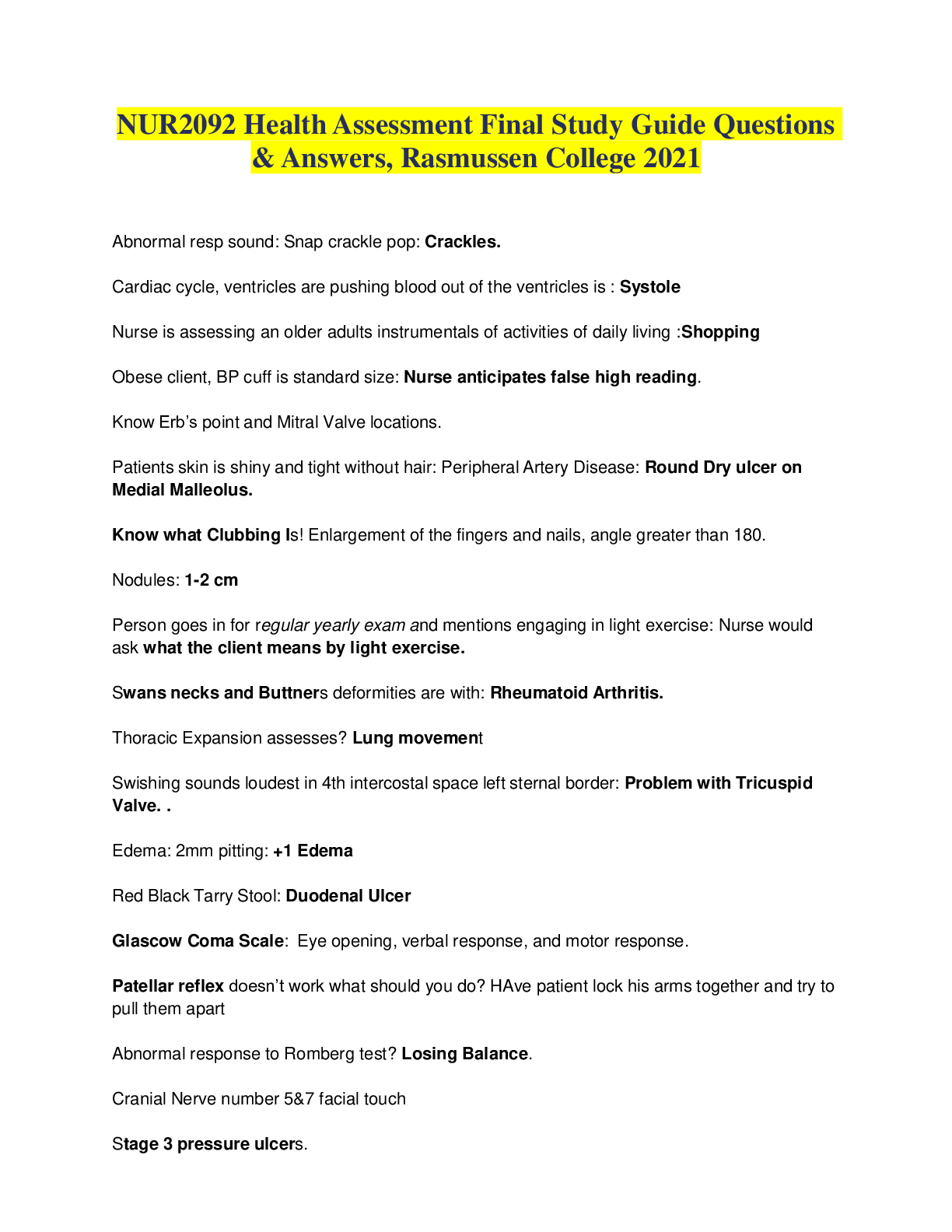
Reviews( 0 )
Document information
Connected school, study & course
About the document
Uploaded On
Sep 24, 2021
Number of pages
39
Written in
Additional information
This document has been written for:
Uploaded
Sep 24, 2021
Downloads
0
Views
35

